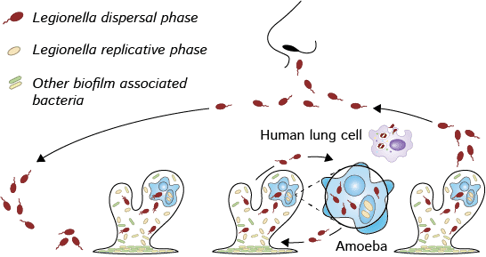What is Legionella?
Legionella is a pathogenic group of bacteria. There are as many as 42 different species of Legionella, but the species involved in 95% of cases of severe unusual pneumonia is Legionella pneumophila (of which there are 15 serogroups). Serogroup 1 accounts for up to 70 to 92% of laboratory-detected legionellosis cases. 3
Legionnaires’ disease, the most serious and most well-known variety of legionellosis, was named after the event where it was first discovered in 1976 – the American Legionnaires’ Convention in Philadelphia - where 182 people were reported ill and 29 people died. 4
Legionella becomes dangerous when it grows in purpose-built systems - such as cooling towers, potable water systems in hospitals, homes, fountains, spa pools, misting devices, etc. - where water is maintained at a temperature of 20° to 50° Celsius (68° to 122° Fahrenheit).
Such water systems encourage the growth of biofilms creating expanded surfaces for Legionella to multiply. Biofilms consist of other bacteria, algae or amoeba and their secretions that can protect Legionella.
Read More About Legionella and Legionnaires' disease
In order to understand why Legionella bacteria is so dangerous and how it can infect the human lungs, it is crucial to first understand the lifecycle of the bacteria.
THE LIFECYCLE OF LEGIONELLA
Legionella pneumophila has two distinct phases to its life cycle: the replicative phase where it multiplies and the motile, dispersal phase, where it is looking for a new host and moving freely in the water system.1 This phase is sometimes referred to as Viable but Non-culturable (VBNC).

1. Attachment to surface and replicative phase
During the motile phase the Legionella bacterium is seeking a new host and usually finds an amoebic host cell within biofilm. 2
Once the Legionella installs itself inside a host amoeba it changes to its replicative phase and starts to multiply.1
Protected inside the amoebic host, the Legionella population can grow quickly especially between the temperatures of 20° and 55° centigrade.2
2.Formation of the dispersal (or motile) phase
Within the amoebic host environment, the Legionella quickly uses up the available resources. Having exhausted the resources of its host, the Legionella reverts to the motile dispersal phase and breaks through the amoeba cell wall to seek a new host.1
3. Motile phase and detachment from biofilm
In the motile phase, Legionella develops a shorter, thicker body with a flagellum and takes on a lower respiratory life form.
The motile phase leads Legionella to exit from the host cell through the amoebic cell wall. It can then either find a new host amoeba (within the surrounding biofilm) or move free of the biofilm into the greater water system.1
4. Formation of aerosols and human infection
In the motile phase, Legionella is at its most virulent and dangerous. Once free of the biofilm and in the general water system, Legionella can be taken up by aerosol droplets - caused by any agitation of the water near a water/air interface, e.g. a showerhead or cooling tower.
Humans can inhale the Legionella in the aerosol droplets and once in the respiratory system, the Legionella will attack human lung cells, in the same way that it attacks an amoebic cell, which it resembles.1
5. Implications for disease control and detection
Disease
It is the motile phase of the Legionella bacterium which causes disease.
Sampling
Although seldom referred to in the Legionella risk management literature, the motile phase is the most common phase of Legionella encountered in a sample taken from a water system.1
To sample the replicative phase of Legionella a biofilm sample, usually a swab test, is required. The replicative phase is very less likely to be sampled in the free water system.
Detection
During its motile phase and when it is at its most dangerous to humans, the Legionella bacterium is not replicating and is therefore difficult to detect through culture methods. This is one of the reasons that lab culture tests have lower recovery rates. According to Garduño, profesor of Microbiology and Immunology,
“We should keep in mind that growth in the lab is irrelevant to the life cycle and natural history of L. pneumophila”.1
Why Lab Culture Test Cannot Protect You and Your Business From Legionnaires' disease?
Legionella antigen and DNA can be detected in either phase and therefore methods of detection which detect Legionella antigen or DNA are better at detecting the bacterium when it is an immediate danger to humans.
Find Out More About Legionella Testing Methods
References:
1. Garduño, R. (2008). Infectious Diseases And Pathogenesis, pp.65-84. Available at: http://bit.ly/2lXfHNf [Accessed 18 May. 2018].
2. Abdel-Nour, M., Duncan, C., Low, D. and Guyard, C. (2013). International Journal of Molecular Sciences, 14(11), pp.21660-21675. Available at: http://bit.ly/2mp70LX [Accessed 18 May. 2018].
3. Mercante, J. and Winchell, J. (2015). Clinical Microbiology Reviews, 28(1), pp.95-133. Available at: http://bit.ly/2moFWwl [Accessed 18 May 2018].
4. Cdc.gov. (2017). Available at: http://bit.ly/2m1H74g [Accessed 18 May 2018].

